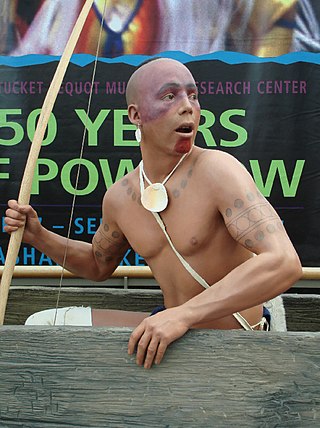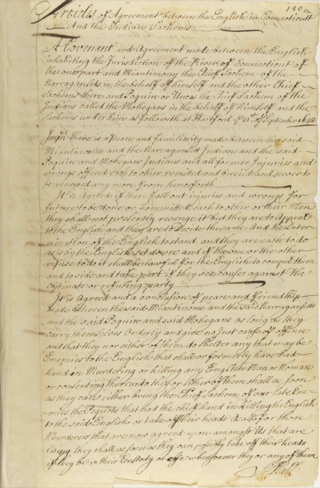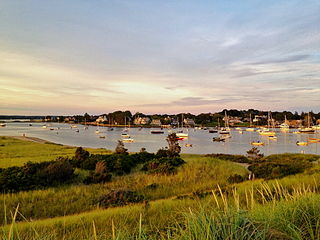Related Research Articles

The Pequot are a Native American people of Connecticut. The modern Pequot are members of the federally recognized Mashantucket Pequot Tribe, four other state-recognized groups in Connecticut including the Eastern Pequot Tribal Nation, or the Brothertown Indians of Wisconsin. They historically spoke Pequot, a dialect of the Mohegan-Pequot language, which became extinct by the early 20th century. Some tribal members are undertaking revival efforts.

King Philip's War was an armed conflict in 1675–1676 between a group of indigenous peoples of the Northeastern Woodlands and the English New England Colonies and their indigenous allies. The war is named for Metacomet, the Pokanoket chief and sachem of the Wampanoag who adopted the English name Philip because of the friendly relations between his father Massasoit and the Plymouth Colony. The war continued in the most northern reaches of New England until the signing of the Treaty of Casco Bay on April 12, 1678.

Miantonomoh, also spelled Miantonomo, Miantonomah or Miantonomi, was a chief of the Narragansett people of New England Indians.

Uncas was a sachem of the Mohegans who made the Mohegans the leading regional Indian tribe in lower Connecticut, through his alliance with the New England colonists against other Indian tribes.

The Pequot War was an armed conflict that took place in 1636 and ended in 1638 in New England, between the Pequot tribe and an alliance of the colonists from the Massachusetts Bay, Plymouth, and Saybrook colonies and their allies from the Narragansett and Mohegan tribes. The war concluded with the decisive defeat of the Pequot. At the end, about 700 Pequots had been killed or taken into captivity. Hundreds of prisoners were sold into slavery to colonists in Bermuda or the West Indies; other survivors were dispersed as captives to the victorious tribes.

The Niantic are a tribe of Algonquian-speaking American Indians who lived in the area of Connecticut and Rhode Island during the early colonial period. They were divided into eastern and western groups due to intrusions by the more numerous and powerful Pequots. The Western Niantics were subject to the Pequots and lived just east of the mouth of the Connecticut River, while the Eastern Niantics became very close allies to the Narragansetts. It is likely that the name Nantucket is derived from the tribe's endonym, Nehantucket.
Sassacus was a Pequot sachem who was born near present-day Groton, Connecticut. He became grand sachem after his father, Tatobem, was killed in 1632. The Mohegans led by sachem Uncas rebelled against domination by the Pequots. Sassacus and the Pequots were defeated by English colonists allied with the Narragansett and Mohegans in the Pequot War.

Ninigret was a sachem of the eastern Niantic Indian tribe in New England at the time of colonization, based in Rhode Island. In 1637, he allied with the colonists and the Narragansetts against the Pequot Indians.
Wyandanch (c. 1571 – 1659 was a sachem of the Montaukett Indians in the mid-17th century on eastern Long Island. Initially he was a minor chief among the Montaukett, but due to his skillful manipulation of various alliances and his accommodating stance towards the European colonists who gave him substantial military and economic support, he eventually became an influential "alliance chief" (a sachem who was responsible for maintaining friendly relations between his tribe and the settlers).

The Mystic massacre – also known as the Pequot massacre and the Battle of Mystic Fort – took place on May 26, 1637 during the Pequot War, when a force from Connecticut Colony under Captain John Mason and their Narragansett and Mohegan allies set fire to the Pequot Fort near the Mystic River. They shot anyone who tried to escape the wooden palisade fortress and killed most of the village. There were between 400 and 700 Pequots killed during the attack; the only Pequot survivors were warriors who were away in a raiding party with their sachem Sassacus.
Oneco was a sachem of the Mohegans in the Connecticut Colony and the son of Uncas. During King Philip's War (1675–78) he distinguished himself as a battlefield commander and has been credited as one of the executioners of Canonchet. Later, he was the lead petitioner in a legal case that tested whether the Mohegan sachemate was a political entity equal to The Crown.
The Mohegan are an Algonquian Native American tribe historically based in present-day Connecticut. Today the majority of the people are associated with the Mohegan Indian Tribe, a federally recognized tribe living on a reservation in the eastern upper Thames River valley of south-central Connecticut. It is one of two federally recognized tribes in the state, the other being the Mashantucket Pequot, whose reservation is in Ledyard, Connecticut. There are also three state-recognized tribes: the Schaghticoke, Paugusett, and Eastern Pequot.

The Great Swamp Fight or the Great Swamp Massacre was a crucial battle fought during King Philip's War between the colonial militia of New England and the Narragansett people in December 1675. It was fought near the villages of Kingston and West Kingston in the Colony of Rhode Island and Providence Plantations. The combined force of the New England militia included 150 Pequots, and they inflicted a huge number of Narragansett casualties, including many hundred women and children. The battle has been described as "one of the most brutal and lopsided military encounters in all of New England's history." Since the 1930s, Narragansett and Wampanoag people commemorate the battle annually in a ceremony initiated by Narragansett-Wampanoag scholar Princess Red Wing.

Fort Shantok, in Montville, Connecticut, was the site of the principal Mohegan settlement between 1636 and 1682 and the sacred ground of Uncas, one of the most prominent and influential Mohegan leaders and statesmen of his era. Originally part of Mohegan reservation lands, the property was taken by the state of Connecticut in the 20th century and Fort Shantok State Park was established. In 1995, following legal action by the tribe to recover its lands, the state returned the park to Mohegan control. The tribe now operates the area, part of its reservation, as a local park. The grounds were declared a National Historic Landmark in 1993.

The Mohegan Tribe is a federally recognized tribe and sovereign tribal nation of the Mohegan people. Their reservation is the Mohegan Indian Reservation, located on the Thames River in Uncasville, Connecticut.

The Treaty of Hartford was a treaty concluded between English colonists in Connecticut, the Mohegan nation and the Narragansett nation on September 21, 1638, in Hartford, Connecticut.

Harman Garrett was a Niantic sachem and then governor of the Eastern Pequots slightly east of the Pawcatuck River in what is now Westerly, Rhode Island. His chosen English name was very similar to that of Herman Garrett, a prominent colonial gunsmith from Massachusetts in the 1650s.
Robin Cassacinamon (c.1620s-1692) was a Pequot Indian governor appointed by the United Colonies to govern Pequots in southeastern Connecticut.
Pessicus was a Narragansett Indian leader who was killed during King Philip's War.

Quaiapen was a Narragansett-Niantic female sachem (saunkskwa) who was the last sachem captured or killed during King Philip’s War.
References
- 1 2 3 4 Drake, James (March 1997). "Restraining Atrocity: The Conduct of King Philip's War". The New England Quarterly. 70 (1): 33–56. doi:10.2307/366526. JSTOR 366526 . Retrieved 23 October 2021.
- 1 2 3 4 5 George Sheldon (1895). A History of Deerfield, Massachusetts: The Times when the People by Whom it was Settled, Unsettled and Resettled, Volume 1. Press of E.A. Hall & Company. pp. 145–147. OCLC 1037205541.
- ↑ Castro, Wendy Lucas (Spring 2008). "Stripped: Clothing and Identity in Colonial Captivity Narratives". Early American Studies. 6 (1): 104–136. doi:10.1353/eam.2008.0003. JSTOR 23546568. S2CID 145000015 . Retrieved 23 October 2021.
- ↑ Bennett, M. K. (October 1955). "The Food Economy of the New England Indians, 1605-75". Journal of Political Economy. 63 (5): 369–397. doi:10.1086/257706. JSTOR 1826569. S2CID 154207490 . Retrieved 23 October 2021.
- ↑ Slade, M. B. C. (December 16, 1876). "Distinguished Indians". New England Journal of Education. 4 (23): 272–273. JSTOR 44771663 . Retrieved 23 October 2021.
- ↑ Leach, Douglas Edward (September 1961). "The "Whens" of Mary Rowlandson's Captivity". The New England Quarterly. 34 (3): 352–363. doi:10.2307/362932. JSTOR 362932 . Retrieved 23 October 2021.
- 1 2 Calloway, Colin G. (June 2006). "Review: [Untitled]". The Journal of American History. 93: 1. doi:10.2307/4486074. JSTOR 4486074 . Retrieved 23 October 2021.
- ↑ American National Biography (New York: Oxford University Press, 1999) p. 34
- ↑ Wheeler, Richard Anson (1875). History of the First Congregational Church, Stonington, Conn., 1674-1874: With the Report of Bi-centennial Proceedings, June 3, 1874. With Appendix Containing Statistics of the Church. T. H. Davis & Company.
- ↑ Pulsipher, Jenny Hale (2003). ""Subjects... Unto the Same King": New England Indians and the Use of Royal Political Power". Massachusetts Historical Review. 5: 29–57. JSTOR 25081179 . Retrieved 23 October 2021.
Attribution
- This article incorporates text from a publication now in the public domain : Wilson, J. G.; Fiske, J., eds. (1900). . Appletons' Cyclopædia of American Biography . New York: D. Appleton.